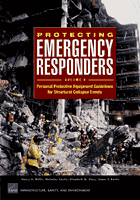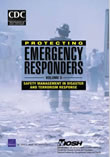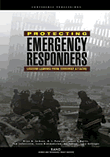 |
Protecting Emergency Responders
Many emergency response workers do not believe that they are adequately
prepared to respond to a major disaster such as the World Trade Center
attack or the anthrax scare, according to four reports of worker input
released by RAND and NIOSH. The first two reports show a need for research,
training and other strategic approaches to help protect emergency responders
in terrorist attacks. The third report recommends that better planning,
training, coordination and management procedures are needed to protect
emergency responders at the scene of terrorist attacks and disasters.
 Personal Protective Equipment Guidelines for Structural Collapse Events, Rand Volume 4 Personal Protective Equipment Guidelines for Structural Collapse Events, Rand Volume 4
External Link: http://www.rand.org/pubs/monographs/MG425/
This monograph serves as a technical source for National Institute for Occupational Safety and Health (NIOSH) incident commander guidelines for emergency response immediately following large structural collapse events. It characterizes response activities and expected hazards, and develops guidelines for selecting appropriate personal protective equipment (PPE).
 Protecting
Emergency Responders, Volume 3: Safety Management in Disaster and Terrorism
Response Protecting
Emergency Responders, Volume 3: Safety Management in Disaster and Terrorism
Response
DHHS (NIOSH) Publication No. 2004-144
This report describes a recent joint NIOSH-RAND study of safety management
practices and issues related to the protection of emergency workers who
respond to large-scale disasters and terrorist attacks. The study focused
on traditional emergency responders--fire fighters, law enforcement officers,
and emergency medical personnel--as well as others who engage in response,
rescue, and recovery operations, including government and public health
professionals; skilled support personnel, such as construction, utility
and transport workers; disaster relief workers; and volunteers. The report
includes recommendations addressing a wide range of relevant issues, including:
- gathering and analyzing information on hazards, the responders themselves,
and responder injuries and illnesses;
- making appropriate safety management decisions;
- implementing safety controls and procedures;
- training responders and managers;
- preparing through planning and exercises;
- and integrating and coordinating safety management activities from
a site-wide, multiple agency perspective.
The recommendations are based largely on input received from emergency
responders and managers who have been engaged in recent major disaster
responses, including the 9/11 terrorist attacks on New York City and the
Pentagon, Hurricane Andrew, and the Northridge Earthquake. The recommendations
are consistent with the current standard approach to incident management
used widely in emergency response, and with the new National Incident
Management System and the National Response Plan.
 Protecting
Emergency Responders, Volume 2: Community Views of Safety and Health Risks
and Personal Protection Needs Protecting
Emergency Responders, Volume 2: Community Views of Safety and Health Risks
and Personal Protection Needs
External Link: http://www.rand.org/publications/MR/MR1646/
Firefighters, law enforcement officers, and emergency medical service
responders play a critical role in protecting people and property in the
event of fires, medical emergencies, terrorist acts, and numerous other
emergencies. The authors examine the hazards that responders face and
the personal protective technology needed to contend with those hazards.
The findings are based on in-depth discussions with 190 members of the
emergency responder community and are intended to help define the protective
technology needs of responders and develop a comprehensive personal protective
technology research agenda.
 Protecting
Emergency Responders: Lessons Learned from Terrorist Attacks Protecting
Emergency Responders: Lessons Learned from Terrorist Attacks
External Link: http://www.rand.org/publications/CF/CF176
This report presents a summary of a December 2001 working conference,
sponsored by the National Institute for Occupational Safety and Health.
Attending were emergency workers who responded to the bombing of the Murrah
Building in Oklahoma City, the September 11 attacks on the World Trade
Center and the anthrax incidents that occurred during autumn 2001. The
report addresses the equipment, training and information required to protect
emergency responders as they meet the challenge of protecting their communities.
For summary information see NIOSH Updates:
|
 |
|

